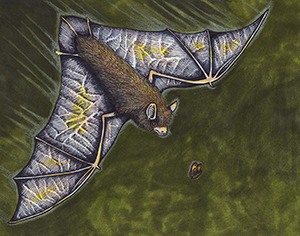Submitted by Kwiaht staff
Special to the Islands’ Weekly
Two family-oriented evening wildlife adventures in Lopez village celebrate local efforts to reduce outdoor lighting and its impacts on animals that rely on darkness to hunt, mate and migrate.
On Sunday July 28 at 8:30 p.m., state wildlife biologist Ella Rowan will talk about current issues in Northwest bat research, followed by a village walk with a bat detector to listen in on the navigation and feeding of local bats.
Rowan is visiting Lopez to conduct the first systematic census of bats flying the island using special recording equipment that will be set up at 27 locations in fields, wetlands, and woodlands. Russel Barsh of Kwiaht and Nick Teague of BLM are providing local support.
Rowan says that 15 species of bats have been documented in Washington state, but it remains unclear how many of those species live in the islands, how many there are, and what kinds of habitat, prey and winter shelter they use.
Last year, Washington state regional wildlife biologist Ruth Milner confirmed that one of the largest colonies of federally listed Townsend’s big-eared bats in the state lives on Lopez, a surprise that has generated more interest in island bat ecology.
Moths feed bats, and on Thursday, August 1 at 9:30 pm, Russel Barsh will talk on the hidden world of Lopez moths, followed by visits to several moth traps set around the water’s edge and Weeks Wetland.
While moths are very close relatives of the butterflies, Barsh says, they use the position of the moon to navigate, and their sense of smell to find mates. Night flying helps protect moths from birds but not from bats. In fact, moths may make up most of Lopez bats’ food supply in the winter, when most insects are dormant.
Because they fly and mate at night, most moths are dull colored – and also poorly studied.
“Hundreds of species go unnoticed every time the sun goes down,” Barsh adds. “But they are fat and tasty to bats and other nighttime hunters such as frogs, shrews, and other insects.”
Some moths are also beautifully patterned for daytime camouflage when they rest.
Others, like the shocking pink sheep moth, stand out in daylight, and may use their bright colors as a warning to predators.
Few moth species are actually poisonous, however. Many have evolved ways of detecting bats’ echolocation clicks, or even clicking back to confuse the bats pursuing them.
“Nature’s aerial warfare,” Barsh said.
He also points out that the distant ancestors of today’s moths and butterflies were more like moths, and the characteristics we associate with butterflies such as day-flying, drinking nectar and helping pollinate flowers probably evolved only 60-70 million years ago – about 10 million years before the appearance of the first bats in the fossil record.
Both events are free, and begin on the patio of the Kwiaht office on the back side of Lopez Plaza, facing Weeks Wetland.



